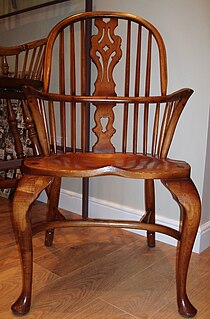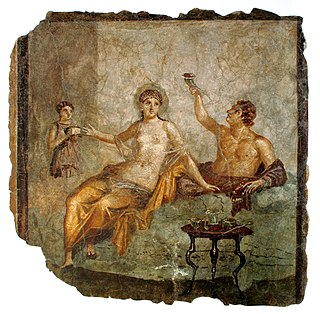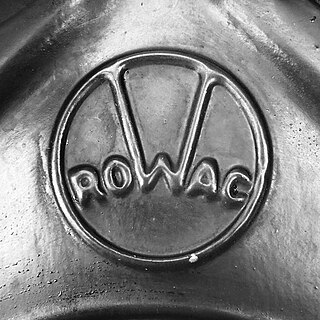
Furniture refers to movable objects intended to support various human activities such as seating, eating (tables), storing items, eating and/or working with an item, and sleeping. Furniture is also used to hold objects at a convenient height for work, or to store things. Furniture can be a product of design and can be considered a form of decorative art. In addition to furniture's functional role, it can serve a symbolic or religious purpose. It can be made from a vast multitude of materials, including metal, plastic, and wood. Furniture can be made using a variety of woodworking joints which often reflects the local culture.

Lotus position or Padmasana is a cross-legged sitting meditation pose from ancient India, in which each foot is placed on the opposite thigh. It is an ancient asana in yoga, predating hatha yoga, and is widely used for meditation in Hindu, Tantra, Jain, and Buddhist traditions.

A writing table has a series of drawers directly under the surface of the table, to contain writing implements, so that it may serve as a desk. Antique versions have the usual divisions for the inkwell, the blotter and the sand or powder tray in one of the drawers, and a surface covered with leather or some other material less hostile to the quill or the fountain pen than simple hard wood.

A commode is any of many pieces of furniture. The Oxford English Dictionary has multiple meanings of "commode". The first relevant definition reads: "A piece of furniture with drawers and shelves; in the bedroom, a sort of elaborate chest of drawers ; in the drawing room, a large kind of chiffonier." The drawing room is itself a term for a formal reception room, and a chiffonier is, in this sense, a small sideboard dating from the early 19th century.
Chairs are known from Ancient Egypt and have been widespread in the Western world from the Greeks and Romans onwards. They were in common use in China from the twelfth century, and were used by the Aztecs. In Sub-Saharan Africa, chairs was not in use before introduced by Europeans.

A table is an item of furniture with a raised flat top and is supported most commonly by 1 or 4 legs, used as a surface for working at, eating from or on which to place things. Some common types of table are the dining room table, which is used for seated persons to eat meals; the coffee table, which is a low table used in living rooms to display items or serve refreshments; and the bedside table, which is commonly used to place an alarm clock and a lamp. There are also a range of specialized types of tables, such as drafting tables, used for doing architectural drawings, and sewing tables.

A curule seat is a design of a (usually) foldable and transportable chair noted for its uses in Ancient Rome and Europe through to the 20th century. Its status in early Rome as a symbol of political or military power carried over to other civilizations, as it was also used in this regard by kings in Europe, Napoleon, and others.
Campaign furniture is a type of furniture which is made for travel. Historically, much of it was made for military campaigns.

Viparita Dandasana or Inverted Staff Pose is an inverted back-bending asana in modern yoga as exercise. It may be performed with both feet on the ground, or with one leg raised straight up.

A club foot is a type of rounded foot for a piece of furniture, such as the end of a chair leg. It is also known by the alternative names pad foot and Dutch foot, the latter sometimes corrupted into duck foot.

A cabriole leg is one of (usually) four vertical supports of a piece of furniture shaped in two curves; the upper arc is convex, while lower is concave; the upper curve always bows outward, while the lower curve bows inward; with the axes of the two curves in the same plane. This design was used by the ancient Chinese and Greeks, but emerged in Europe in the very early 18th century, when it was incorporated into the more curvilinear styles produced in France, England and Holland.

Turned chairs — sometimes called thrown chairs or spindle chairs — represent a style of Elizabethan or Jacobean turned furniture that were in vogue in the late 16th and early 17th century England, New England and Holland. In turned furniture, the individual wooden spindles of the piece are made by shaping them with chisels and gouges while they are being turned on a lathe. Joiners or carpenters who made such furniture were termed "turners", or "bodgers", hence the surname Turner. Today, turned chairs — as well as various turned decorative elements — are still commonly made, but by machines rather than by hand.

A close stool was an early type of portable toilet, made in the shape of a cabinet or box at sitting height with an opening in the top. The external structure contained a pewter or earthenware chamberpot to receive the user's excrement and urine when they sat on it; this was normally covered (closed) by a folding lid. "Stool" has two relevant meanings: as a type of seat and as human feces. Close stools were used from the Middle Ages until the introduction of the indoor flush toilet.

Danish modern is a style of minimalist furniture and housewares from Denmark associated with the Danish design movement. In the 1920s, Kaare Klint embraced the principles of Bauhaus modernism in furniture design, creating clean, pure lines based on an understanding of classical furniture craftsmanship coupled with careful research into materials, proportions, and the requirements of the human body.
The Heywood-Wakefield Company is an American furniture manufacturer established in 1897. It went on to become a major presence in the US. Its older products are considered collectibles and have been featured on Antiques Roadshow.

A stool is a raised seat commonly supported by three or four legs, but with neither armrests nor back a backrest, and typically built to accommodate one occupant. As some of the earliest forms of seat, stools are sometimes called backless chairs despite how some modern stools have backrests. Folding stools can be collapsed into a flat, compact form typically by rotating the seat in parallel with fold-up legs.

Ancient furniture was made of many different materials, including reeds, wood, stone, metals, straws, and ivory. It could also be decorated in many different ways. Sometimes furniture would be covered with upholstery, upholstery being padding, springs, webbing, and leather. Features which would mark the top of furniture, called finials, were common. To decorate furniture, contrasting pieces would be inserted into depressions in the furniture. This practice is called inlaying.

The Centripetal Spring Chair or Armchair was a 19th-century American office chair, and one of the first modern designs for office chairs.

Rowac was a hardware factory founded by Carl Robert Wagner in 1888 in Chemnitz, Germany which most notably produced furniture for industrial use. Carl Robert Wagner is regarded as the inventor of the steel stool, which among other things was chosen for the workshops and classrooms of the Bauhaus Dessau. Today, mainly stools, chairs and cabinets carrying the Rowac name are traded as antiques.

















